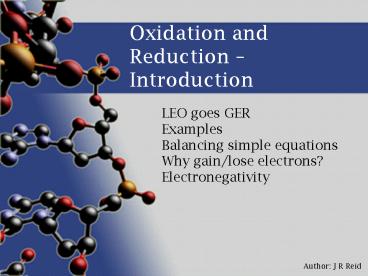Oxidation and Reduction Introduction - PowerPoint PPT Presentation
1 / 11
Title:
Oxidation and Reduction Introduction
Description:
The equation above has a total of no charge on the left but one on the right. ... losers of electrons are at the bottom, left hand corner of the periodic table ... – PowerPoint PPT presentation
Number of Views:91
Avg rating:3.0/5.0
Title: Oxidation and Reduction Introduction
1
Oxidation and Reduction Introduction
- LEO goes GER
- Examples
- Balancing simple equations
- Why gain/lose electrons?
- Electronegativity
2
Defining Oxidation and Reduction
- Chemistry is all about atoms making or breaking
bonds with other atoms. Sometimes atoms lose the
hold over their electrons, or they may gain
another atoms electrons - Oxidation when an atom loses its electrons
- Reduction when an atom gains more electrons
than it had before - A quick way to remember this is
- LEO goes GER
- Loss of Electrons is Oxidation
- Gain of Electrons is Reduction
3
Examples
- Oxidation
- Al ? Al3 3e-
- Fe2 ? Fe3 e-
- 2F- ? F2 2e-
- Reduction
- Al3 3e- ? Al
- Fe3 e- ? Fe2
- F2 2e- ? 2F-
4
Exercises Oxidation or Reduction?
- Identify these reactions as either oxidation or
reduction reactions - O2 4e- ? 2O2-
- H2 ? 2H 2e-
- Zn ? Zn2 2e-
- MnO4- 8H 5e- ? Mn2 4H2O
- Cr2O72- 14H 6e- ? 2Cr3 7H2O
5
Balancing Simple Equations
- We know from previous years that equations need
to be balanced, e.g. - H2 Cl2 ? 2HCl
- We also have to balance equations to make all the
charges balance, e.g. - H ? H
- The equation above has a total of no charge on
the left but one on the right. - We can add electron(s) (i.e. one negative) to any
side to make both sides charges balance, e.g. - H ? H e-
6
Exercises Completing and Balancing Equations
- Balancing Equations
- Na Cl2 ? NaCl
- Mg HNO3 ? Mg(NO3)2 H2
- Balancing Ionic Equations
- Na O2- ?
- Al3 OH- ?
- Balancing Redox Half Equations
- Na ? Na
- F2 ? 2F-
- O2- ? O2
7
Why Gain or Lose Electrons?
- Atoms hold their electrons in shells (otherwise
known as energy levels). - As we add more electrons we fill up these levels
- The first level can hold 2 electrons
- The second level can hold 8 electrons
- The third level can hold 8 electrons
- Atoms become stable when their levels (shells)
are full. - Note Electron configuration is the name we
give to the arrangement of the electrons within
atoms or ions, e.g. Sodiums electron
configuration is 2, 8, 1
8
Exercises Stable Shells
9
Electronegativity
- Some elements are better at bonding to electrons
than others. This feature is called
electronegativity and is discussed in more
detail in the Atoms and Bonding topic. - Elements with greater electronegativity will hold
their electrons more strongly they are less
likely to be oxidised (in fact they are more
likely to end up gaining electrons) - Elements with weak electronegativity have a weak
hold on their electrons, they are more likely to
lose them and therefore are more likely to be
oxidised
10
Electronegativity Trends
- The general rule is that electronegativity
increases as you move towards the right and the
top of the periodic table - This means that fluorine is the best holder and
taker of electrons (notice that weve ignored
group 18 why?) - Therefore the best losers of electrons are at the
bottom, left hand corner of the periodic table
11
Applied Electronegativity
- We can use this trend to predict what will happen
when two chemicals are put together. Here are
some examples - Cl- and F2 are put together Chlorine is a
better loser than Fluorine so - 2Cl- F2 ? 2F- Cl2
- (Chlorine loses electrons and Fluorine gains)
- Na and Cl2 are put together
- 2Na Cl2 ? 2Na 2Cl-
- (Sodium is the loser, chlorine is the gainer)































